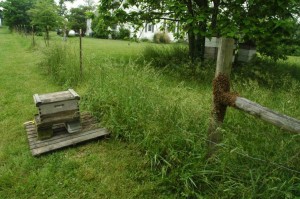We continue our inexorable “snowball heading for hell” momentum.
First, you have MCA, George “Goober” Lindsay, AND Maurice Sendak passing on in the span of a few days.
And out there in the world, the results in Europe’s elections presage much short-term chaos and uncertainty. On the plus side of the ledger, they do indicate a slightly cheering determination on the part of Continentals to show the political/banking elites that the people are still in charge.
No such luck over here, where American domestic partisan politics keeps getting dumber and dumberer and the narrowness of the issues being debated–in the face of the need for an overwhelming overhaul–is mind-boggling.
This is my context-establishing tweet of the week, and it comes not from our political leaders or respected mainstream media sources. No, it comes from from Dan Alpert, managing partner of a New York investment bank, and it shows just how dire the straits are in USA 2012:
In a nation of 315 million people we have 115mm full time workers and 26.7mm part time (1-34 hours) workers. Not thriving!
Does anyone expect either party to address this before the next election in a meaningful way? Or ever?
****
But I won’t allow that to harsh my buzz. (Oh, yes, I did. I did make that terrible pun.) Because, you see, the world is for shit but my bees are thriving, and sometimes that’s enough for me.
Been a great year for the nectar flow, which started very early and is still going great guns, so much so that I woke with a start last night with the realization that I’ve got three bee hives partially resting on a single horizontal plank, with an unprecedented mass of honey above. (File under complications resulting from unusual natural bounties–along with my heifer who died from bloat caused by the insanely rich pasture this spring.)
Another consequence of the nectar bounty is that hives become so strong that they swarm. Which is really not a bad thing for the bees. But for a beekeeper, aka honey thief, you like to avoid having swarms take away half your bee population, so if you’re lucky and observant you can catch your own swarms, which I did this weekend, twice.
On Saturday, after a little set-to with my increasingly emotional 11-year-old son (another ominous trend), I stomped out of the house and wandered to the beeyard, where they were swarming for the second day in a row.
If you’ve never stood in the middle of a bee swarm, put it on your bucket list. It feels like the early stages of the apocalypse might feel, and yet it’s really just a beautiful natural thing. Basically, the bee super-organism feels it is robust enough to reproduce, so it swarms. In a first swarm, roughly half the bees (five thousand, ten perhaps) accompany the old queen and look for a new home. Upon leaving the hive they fly in mad-seeming circles, creating a cone of bees about ten yards wide and forty feet high. It is noisy and scary and exhilarating. I half expect the voice of James Earl Jones to begin booming out.
The bees in this state are about as gentle as they can be. They’ve gorged on honey prior to leaving the hive, and are merely seeking an intermediate place to settle while the scouts find a permanent location. Lucky for me, they roost on a fence post right next to the hive, the same place another swarm had chosen just yesterday (and not, say, on a branch sixty feet off the ground).
I set to putting them into a temporary hive, as I had done with Friday’s swarm.
And let me talk about the Nasonov pheremone for a brief moment. Because it means a lot to me.
When I ponder all I’ve gained in moving to the country from a house and respectably well-paid job in New York, and giving up all that goes with same — annual 401k contributions, good health insurance, paid holidays, pay! — I can now add as a compensation an intimate familiarity with the workings of the Nasonov pheremone, which is what worker bees release to orient returning forager bees back to the colony.
When capturing swarms, beekeepers are looking for the distinctive butt-up, fanning behavior (displaying the Nasonov gland) as an indication that they have succeeded in transporting the queen from the temporary roost to the intended hive destination. To start moving the swarm I scoop handfuls of bees into the box. One random scoop had what looked like a virgin queen but I wasn’t entirely sure. When I laid the scoop into the box, bingo! The timbre of the buzzing changed instantly and dozens of bees suddenly stationed themselves at the edges of the box and began the fanning action. My work was pretty much done at this point. I walked away and returned at dusk, and the hive was full. All I had to do was put the hive cover on.
It’s possible that our generation may lose bees altogether. I won’t lay out the case for bee extinction, but a few minutes of googling around, and you will at least be familiar with it. It occurs to me as I type this that our kids’ kids won’t know what a real drone is, but they will be all too familiar with the mechanized war-fighting snooping machines that are named after the least useful members of the bee family. On that subject, I highly recommend reading Marcy Wheeler’s response to Drunken Predator’s fascinating essay on Oppenheimers and Orwells.
But that is some disturbing, dispiriting stuff, and as I have already said, today I’m not letting that sort of thing harsh my buzz.

